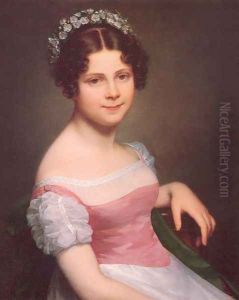Marie-Constance Mayer Paintings
Marie-Constance Mayer, born in 1775, was a notable French artist whose work is celebrated for its delicate sensibility, technical skill, and emotional depth. Mayer's life and career unfolded during a period of significant social and political upheaval, including the French Revolution and the Napoleonic Wars. Despite the challenges posed by the era in which she lived, including the restrictions on women's participation in the arts and public life, Mayer emerged as a prominent painter, primarily known for her portraits, miniatures, and genre scenes that often depicted women and children in intimate, domestic settings.
Mayer was a pupil of Jean-Baptiste Greuze, who was renowned for his genre paintings and sentimental portrayals of domestic life, and her work reflects his influence. She also had connections with Jacques-Louis David, the leading French painter of the neoclassical movement, though her style remained distinct from the severe neoclassicism associated with David and his followers. Mayer's paintings are characterized by their softness, use of light, and the emotional richness they convey, qualities that distinguished her work from that of her contemporaries.
Despite her talent and the acclaim she received during her lifetime, Marie-Constance Mayer faced significant obstacles in her career, not least because of her gender. Women artists were often marginalized in the art world, and Mayer's achievements were no exception. She exhibited her work at the Paris Salon, the official art exhibition of the Académie des Beaux-Arts in Paris, on several occasions, but like many women artists of her time, she was not admitted into the Academy itself. Her relationship with Pierre-Paul Prud'hon, a fellow artist, was both a personal and professional partnership. Prud'hon was already a well-established artist when he met Mayer, and their collaboration was a source of mutual inspiration. Unfortunately, this relationship, coupled with the challenges she faced as a woman artist, has sometimes overshadowed her contributions to the art world.
Marie-Constance Mayer's life came to a tragic end when she died by suicide in 1821. Despite her premature death, Mayer left behind a body of work that continues to be appreciated for its beauty, technical skill, and insight into the human condition. Today, her paintings can be found in museums and collections around the world, serving as a testament to her talent and resilience as an artist. Her legacy is a reminder of the challenges faced by women in the arts, both in her time and in ours, and of the enduring power of creativity and expression.

